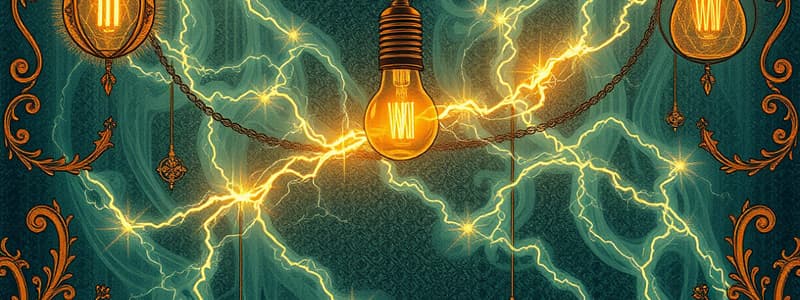Podcast
Questions and Answers
What is the relationship defined by Ohm's Law?
What is the relationship defined by Ohm's Law?
- Voltage (V) is equal to current (I) multiplied by resistance (R) (correct)
- Current (I) is equal to voltage (V) divided by resistance (R)
- Voltage (V) is equal to the square of current (I)
- Resistance (R) is equal to current (I) divided by voltage (V)
In direct current (DC), the current flows periodically back and forth.
In direct current (DC), the current flows periodically back and forth.
False (B)
What is the formula to calculate electric power?
What is the formula to calculate electric power?
P = V × I
The rate at which electrical energy is transferred is known as __________.
The rate at which electrical energy is transferred is known as __________.
Match the following terms with their definitions:
Match the following terms with their definitions:
What is a primary advantage of alternating current (AC)?
What is a primary advantage of alternating current (AC)?
Electromagnetic induction involves generating electric current from a static magnetic field.
Electromagnetic induction involves generating electric current from a static magnetic field.
What are Maxwell's Equations used for?
What are Maxwell's Equations used for?
Flashcards are hidden until you start studying
Study Notes
Ohm's Law
- Defines the relationship between voltage (V), current (I), and resistance (R).
- Formula: V = I × R
- V = voltage (volts)
- I = current (amperes)
- R = resistance (ohms)
- Key points:
- Directly proportional: Voltage increases with current if resistance is constant.
- Inversely proportional: Current decreases with increasing resistance if voltage is constant.
- Used in circuit analysis to calculate unknown values.
AC Vs DC
-
Alternating Current (AC):
- Current changes direction periodically.
- Voltage also varies with time, typically sinusoidal.
- Commonly used in power distribution (e.g., household electricity).
- Advantages: Can be easily transformed to different voltage levels, allowing efficient long-distance transmission.
-
Direct Current (DC):
- Current flows in one direction only.
- Voltage remains constant over time.
- Used in batteries, electronic devices, and solar panels.
- Advantages: Simpler circuitry, more stable for small-scale applications.
Electric Power
- Defined as the rate at which electrical energy is transferred or converted.
- Formula: P = V × I
- P = power (watts)
- V = voltage (volts)
- I = current (amperes)
- Key points:
- Power can also be calculated using resistance: P = I² × R or P = V² / R.
- Important in determining energy consumption and efficiency in electrical devices.
- Measured in watts (W); 1 kW = 1000 W.
Electromagnetism
- Branch of physics that studies the interaction between electric fields and magnetic fields.
- Key concepts:
- Magnetic Fields: Produced by moving electric charges (currents).
- Electromagnetic Induction: The generation of electric current from a changing magnetic field.
- Key application: Transformers and generators.
- Maxwell's Equations: Fundamental equations that describe how electric and magnetic fields are generated and altered by each other and by charges and currents.
- Applications:
- Electric motors, generators, transformers, and various electronic devices.
Ohm's Law
- Establishes the fundamental relationship between voltage (V), current (I), and resistance (R) in electrical circuits.
- Formula: V = I × R, where:
- V represents voltage in volts.
- I represents current in amperes.
- R represents resistance in ohms.
- Key behavior:
- Voltage is directly proportional to current when resistance is constant; as current increases, voltage also increases.
- Current is inversely proportional to resistance when voltage is fixed; as resistance increases, current decreases.
- Essential for solving electrical circuit problems by identifying unknown values.
AC vs. DC
- Alternating Current (AC):
- Current alternates direction periodically, sharing sinusoidal voltage patterns.
- Predominantly used in electrical power distribution systems, such as household electricity.
- Benefits include the ability to easily transform voltage levels for efficient long-distance transmission.
- Direct Current (DC):
- Current flows in a single direction, and voltage remains constant over time.
- Commonly found in batteries, electronic devices, and solar power systems.
- Advantages of DC include simpler circuit design and stability in small-scale applications.
Electric Power
- Electric power is the rate at which electrical energy is converted or transmitted.
- Formula: P = V × I, where:
- P indicates power in watts.
- V indicates voltage in volts.
- I indicates current in amperes.
- Other formulas to calculate power include:
- P = I² × R.
- P = V² / R.
- Crucial for assessing energy use and efficiency in electrical devices.
- Measured in watts (W), with 1 kilowatt (kW) equating to 1000 watts.
Electromagnetism
- A branch of physics that investigates the interplay between electric and magnetic fields.
- Key principles include:
- Magnetic Fields: Arise from moving electric charges or currents.
- Electromagnetic Induction: The process of generating electric current through changing magnetic fields.
- Important applications involve transformers and generators.
- Governed by Maxwell's Equations, which detail how electric and magnetic fields interact with each other and with charges and currents.
- Widely applicable in electric motors, generators, transformers, and various electronic devices.
Studying That Suits You
Use AI to generate personalized quizzes and flashcards to suit your learning preferences.




